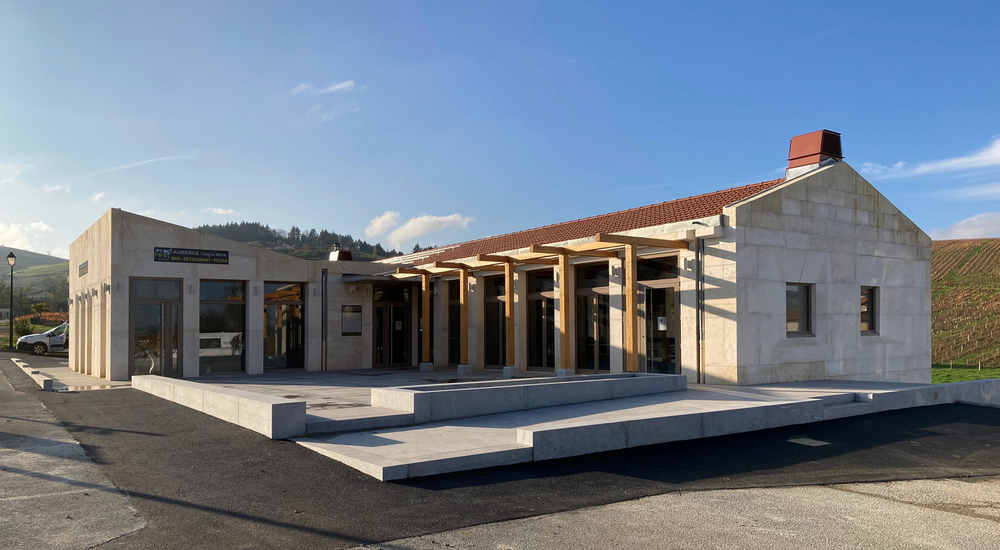The 6 main benefits of building in natural stone
Architectural freedom, social impact, energy balance... Natural stone has great benefits explained by Elisabeth Polzella in Rocalia 2021 show.

Elisabeth Polzella is an architect specializing in natural stone. She crusades to promote the use of this material in building works. Natural stone is “eco-friendly”: everyone likes it but does not necessarily pick it as first choice because of some generally accepted prejudices. However, building in natural stone has a host of benefits, as Elisabeth Polzella explained at the Rocalia trade show in 2019, during her conference entitled "More grey matter for less grey energy".
© Photo credit: Pascal Bois / SNROC
1. Unifying old and new architecture
Elisabeth Polzella says, “It is often said that it is very difficult to integrate new buildings into existing structures, but with natural stone the problem is much easier to solve”.
Stone harmonizes architectural units and its colors, textures and structures will always blend with other building materials. The diversity of natural stone means it fits in everywhere and does not detract from the surroundings.
2. A positive social impact
Elisabeth Polzella believes that “natural stone honors the builders who use it and the people who subsequently use the buildings.” And natural stone also creates a circular economy and promotes non-relocatable employment, answering another of society’s major challenges.
Elisabeth Polzella goes on to say that since the time everything was built from stone, the average life of contemporary buildings has fallen to approximately 25 years. Each generation is now confronted with the decrepitude of what the preceding generation erected. This is why natural stone is really a simple choice – not just for its beauty but because of its durability, solving problems for future generations in advance.
3. Greater architectural freedom
You couldn’t be more wrong if you think that building in stone means no alterations are possible in future years! Swiss architect Luigi Snozzi says, “If you’re looking for flexibility, always build walls in stone.” Elisabeth Polzella agrees that natural stone buildings are very easy to modify provided their designs have been correctly planned upstream. Which makes the challenge all the more interesting for young architects!
“If you cannot push out the walls, natural stone construction makes it possible to change space use. A good example is the buildings in Paris designed by Haussmann that are easy to split into two or three apartments, convert into offices, etc.”.

Dareizé inn (France), a natural stone construction from Elisabeth Polzella.
© Photo credit: Elisabeth Polzella architecte
4. Building design and construction off the beaten tracks
Building with natural stone saves water and needs no sand, two natural resources which the frantic pace of human activity is rapidly using up. Stone building sites are thus cleaner and generate less waste!
From an architect’s point of view, it is also an opportunity to get back to drawing by hand, explains Elisabeth Polzella: “I know many architects who enjoy building with natural stone. Walls are not just two parallel lines. Stone obliges us to consider their thickness too. We also have to think very carefully about site organization, logistics, deadlines, etc.”
5. An investment amortized in the long term
Natural stone has another great benefit: it is an available and abundant resource locally and nationally. There are a high number of soft and hard stone quarries (see the map of quarries in France) and if construction is well planned from the outset, it costs about the same as a synthetic material.
If the investment costs are usually higher, they are quickly compensated by the longer life of the stone buildings and their easy maintenance. Plus the fact that natural stone has excellent thermal inertia, which makes for real HVAC economies.
6. Lower energy balance
Elisabeth Polzella regrets that “today, buildings have to go up fast – often to the detriment of quality and the environment.” The building sector consumes more and more power and is second only to transport as the biggest producer of CO2. If you compare the energy cost of building materials, natural stone gets the best results with 50 kWh/m3 vs. 141,500 kWh/m3 for aluminum – i.e., 2,800 times more!
As its economic circuit is short, natural stone causes less pollution. No energy is needed to manufacture it since it already exists and wastes can easily be recycled as gravel, fill, etc.
Healthy, durable, top quality natural stone has all the advantages architects dream about. Come to Rocalia to discover all the benefits of ornamental and construction stone!




